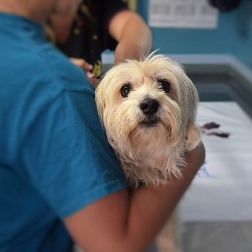How to Choose a Vet Tech Program near Tamarack Minnesota
 Achieving your long term goal of working with and helping pets by enrolling in a veterinary technician program near Tamarack MN may at first seem like a daunting task. After all, you need to search for and enroll in a college that will provide the necessary training to ensure that you can be successful as a veterinary technician. But just how do you approach evaluating and comparing schools so that you can make the correct choice? Many future students launch their due diligence process by searching for schools that are close to their residences. After they have located some local colleges, they ascertain which ones have the lowest tuition and hone in on those. Although location and cost are significant concerns when comparing vet technician programs, they are by no means the only important ones when making your assessments. Factors such as internship programs and accreditation need to be considered also. The point is that there are questions you ought to be asking the vet tech schools you are reviewing before you make a final selection. We have furnished several in this article to help get you started, but before we review them we’ll go over the various roles of vet techs and the training options offered.
Achieving your long term goal of working with and helping pets by enrolling in a veterinary technician program near Tamarack MN may at first seem like a daunting task. After all, you need to search for and enroll in a college that will provide the necessary training to ensure that you can be successful as a veterinary technician. But just how do you approach evaluating and comparing schools so that you can make the correct choice? Many future students launch their due diligence process by searching for schools that are close to their residences. After they have located some local colleges, they ascertain which ones have the lowest tuition and hone in on those. Although location and cost are significant concerns when comparing vet technician programs, they are by no means the only important ones when making your assessments. Factors such as internship programs and accreditation need to be considered also. The point is that there are questions you ought to be asking the vet tech schools you are reviewing before you make a final selection. We have furnished several in this article to help get you started, but before we review them we’ll go over the various roles of vet techs and the training options offered.
The Function of a Veterinary Technician in Tamarack MN
 One of the initial decisions that you will need to make is if you want to train as a veterinary technician, assistant or technologist. Part of your determination might be based on the amount of time and money that you have to invest in your training, but the principal factor will most likely be which specialization interests you the most. What technicians and assistants have in common is that they each work under the immediate guidance of a licensed and practicing veterinarian. And while there are many functions that they can perform within the Tamarack MN veterinary clinic or hospital, they can’t prescribe medications, diagnose conditions, or carry out surgical procedures. In those areas they can only provide support to a licensed veterinarian. There are technologists and technicians that work away from the typical vet practice, for example for animal shelters, zoos or police departments. Let’s take a look at the job functions and training prerequisites for each position.
One of the initial decisions that you will need to make is if you want to train as a veterinary technician, assistant or technologist. Part of your determination might be based on the amount of time and money that you have to invest in your training, but the principal factor will most likely be which specialization interests you the most. What technicians and assistants have in common is that they each work under the immediate guidance of a licensed and practicing veterinarian. And while there are many functions that they can perform within the Tamarack MN veterinary clinic or hospital, they can’t prescribe medications, diagnose conditions, or carry out surgical procedures. In those areas they can only provide support to a licensed veterinarian. There are technologists and technicians that work away from the typical vet practice, for example for animal shelters, zoos or police departments. Let’s take a look at the job functions and training prerequisites for each position.
- Vet Assistants in most cases will have completed a formal training program, either as an intern or apprentice in a practice, or by graduating from a certificate program at a community college or trade school. As the name implies, their job function is to assist the vets and vet technicians in the execution of their duties. Generally they are not associated with more involved tasks, for instance assisting with surgeries. Some of their normal responsibilities may include working at the front desk, cleaning and preparing examination rooms and equipment, or controlling animals during examinations.
- Vet Technicians go through more advanced training in contrast to assistants and typically earn a 2 year Associate Degree, preferably from an American Veterinary Medical Association (AVMA) accredited program. They are in a sense the veterinarian equivalent of medical nurses, since their basic job duty is to assist veterinarians with diagnosing and treating animal patients. Where they stand apart from veterinary assistants is that they are included in more complicated tasks, such as assisting with surgeries or providing medicine. All states presently require veterinary techs pass a credentialing exam for either certification, registration or licensing.
- Vet Technologists are similar to vet techs and for the most part perform the same job functions. They are mandated to obtain a Bachelor’s Degree in veterinary technology, which normally requires four years to complete. Therefore the main difference between a vet technologist and a technician is the technologist’s higher level of education. But with an advanced degree comes more work options, increased salaries and potential management positions. They are also mandated to pass a credentialing examination for either certification, registration or licensing.
Veterinary techs and technologists may specialize in areas such as anesthesia, internal medicine or emergency care. Many may acquire certification from the American Association for Laboratory Animal Science (AALAS) to work in Tamarack MN labs or research facilities also.
Online Vet Tech Programs Offered in Tamarack
 An option that might make sense for those with a hectic lifestyle or who are working full time while attending vet school is to enroll in an online training program. Because the classes are offered via the internet, students can attend on their own schedule wherever a computer is available. The course of study is taught using multiple methods, including videos, slide shows and live streaming webinars. And since many veterinary tech and technologist degrees require practical training, that part can usually be carried out as an internship or work study program at a local Tamarack MN veterinarian clinic or hospital. Distance learning, as it is also called, may in some instances reduce the cost of your education. Tuition and secondary costs, for example for traveling and study supplies, can be cheaper compared to more conventional classroom courses. Just confirm that the online school that you enroll in is accredited, either by the AVMA or another nationally recognized accrediting organization. With the online classes and the clinical training, everything is included for a comprehensive education. So if you are dedicated enough to learn in this more independent manner, an online vet tech program may be the right choice for you.
An option that might make sense for those with a hectic lifestyle or who are working full time while attending vet school is to enroll in an online training program. Because the classes are offered via the internet, students can attend on their own schedule wherever a computer is available. The course of study is taught using multiple methods, including videos, slide shows and live streaming webinars. And since many veterinary tech and technologist degrees require practical training, that part can usually be carried out as an internship or work study program at a local Tamarack MN veterinarian clinic or hospital. Distance learning, as it is also called, may in some instances reduce the cost of your education. Tuition and secondary costs, for example for traveling and study supplies, can be cheaper compared to more conventional classroom courses. Just confirm that the online school that you enroll in is accredited, either by the AVMA or another nationally recognized accrediting organization. With the online classes and the clinical training, everything is included for a comprehensive education. So if you are dedicated enough to learn in this more independent manner, an online vet tech program may be the right choice for you.
Questions to Ask Tamarack MN Veterinary Technician Colleges
 At this point you probably have selected which veterinary credential that you wish to attain, and if you want to study online or attend a college on campus. Since there are an abundance of veterinary community colleges, vocational and trade schools in the Tamarack MN area and across the United States, you need to ask some relevant questions to help narrow down your list of alternatives. As we mentioned in our introduction, many future students start by concentrating on location and the cost of tuition. But we have already touched on other significant qualifiers, such as accreditation and internship programs. And of course you want to select a program that offers the specialty and degree that you want to earn. These and other qualifications are addressed in the list of questions that you need to ask the veterinary technician schools that you are reviewing.
At this point you probably have selected which veterinary credential that you wish to attain, and if you want to study online or attend a college on campus. Since there are an abundance of veterinary community colleges, vocational and trade schools in the Tamarack MN area and across the United States, you need to ask some relevant questions to help narrow down your list of alternatives. As we mentioned in our introduction, many future students start by concentrating on location and the cost of tuition. But we have already touched on other significant qualifiers, such as accreditation and internship programs. And of course you want to select a program that offers the specialty and degree that you want to earn. These and other qualifications are addressed in the list of questions that you need to ask the veterinary technician schools that you are reviewing.
Is the Veterinary Program Accredited? It’s essential that you verify that the veterinary technician school you enroll in is accredited by a regional or national accrediting organization. As previously discussed, one of the most highly respected is the American Veterinary Medical Association (AVMA). Trade schools and colleges that are accredited by the AVMA have undergone a rigorous screening process that confirms you will get a quality education. Also, accreditation is necessary if you are applying for a student loan or financial aid, since numerous programs are not obtainable for non-accredited schools. Last, having a degree or certificate from an accredited program is frequently a requirement for employment for a number of Tamarack MN area veterinarian clinics and hospitals.
What is the School’s Reputation? The veterinary college or trade school and program you select must have an outstanding reputation within the vet field. You can start your due diligence by asking the schools you are reviewing for endorsements from the employers in their job placement network. Other pointers include looking on internet school ranking websites and checking with the school’s accrediting agencies as well. You can ask the Minnesota school licensing authority if there have been any grievances or infractions relating to your specific schools. As a final pointer, phone some Tamarack MN vet clinics that you may want to work for after you receive your training. Find out what they think about your school choices. They might even suggest one or more schools not on your list.
Are there Internship Programs? The best means to obtain clinical hands on training as a vet tech is to work in a medical setting. Find out if the colleges you are reviewing have internship programs arranged with Tamarack MN veterinarians, vet practices or hospitals. Most veterinary medicine programs mandate clinical training and many provide it through internships. Not only will the experience be beneficial as far as the clinical training, but an internship may also help build associations in the local veterinarian community and aid in the search for a position after graduation.
Is there a Job Placement Program? Searching for a job after graduating from a veterinary technician college may be challenging without the assistance of a job placement program. To start with, ask what the graduation rates are for the schools you are evaluating. A lower rate could indicate that the instructors were unqualified to teach the syllabus or that some students were disappointed with the program and quit. Next, check that the colleges have a job placement program and find out what their placement rates are. A high placement rate might mean that the college has an excellent reputation within the Tamarack MN vet community and has a significant network of contacts for student placements. A low rate could signify that the training is not well regarded by employers or that the job assistance program is ineffective at placing students.
How Large are the Classes? If the classes are larger, you most likely will receive little or no personalized instruction from the teachers. Solicit from the Tamarack MN colleges you are researching what their class teacher to student ratios are. You may also decide to participate in a few classes (if practical) to monitor the interaction between students and instructors. Get feedback from students concerning the quality of instruction. Also, speak with the teachers and find out what their backgrounds are as well as their methods of teaching.
Where is the College Located? Okay, we already covered location, but there are several more points to make on the subject. If you are planning to drive to your vet tech classes from your Tamarack MN home, you have to make sure that the commuting time is compatible with your schedule. For instance, driving during the weekend to investigate the route won’t be the same as the drive during rush hour traffic, especially if the school is located close by or within a larger city. Also, if you do choose to attend a school in another state or even outside of your County of residence, there may be increased tuition charges particularly for state and community colleges. On the other hand, taking online classes might be an option that will provide you with more flexibility and minimize the need for travel.
Is the Class Schedule Flexible? And finally, it’s essential that you ascertain if the vet schools you are evaluating offer class times flexible enough to accommodate your schedule. For example, many students continue to work full time and can only attend classes on the weekends or at night near Tamarack MN. Others may only be able to go to classes in the morning or in the afternoon. Make certain that the class times you require are offered before enrolling. Also, find out if you can make up classes that you may miss because of work, sickness or family emergencies. You may discover that an online program is the ideal solution to fit your vet education into your hectic life.
Enrolling in a Vet Tech School near Tamarack MN?
If you have decided to attend a Veterinary Technician Program in the Tamarack Minnesota area, then you may find the following information about the location of your school campus interesting and informing.
Larix laricina
Larix laricina, commonly known as the tamarack,[3]hackmatack,[3]eastern larch,[3]black larch,[3]red larch,[3] or American larch, is a species of larch native to Canada, from eastern Yukon and Inuvik, Northwest Territories east to Newfoundland, and also south into the upper northeastern United States from Minnesota to Cranesville Swamp, Maryland; there is also an isolated population in central Alaska.[4] The word tamarack is an Algonquian name for the species and means "wood used for snowshoes".
Larix laricina is a small to medium-size boreal coniferous and deciduous tree reaching 10–20 m (33–66 ft) tall, with a trunk up to 60 cm (24 in) diameter. Tamaracks and Larches (Larix species) are deciduous conifers. The bark is tight and flaky, pink, but under flaking bark it can appear reddish. The leaves are needle-like, 2–3 cm (3⁄4–1 1⁄4 in) short, light blue-green, turning bright yellow before they fall in the autumn, leaving the pale pinkish-brown shoots bare until the next spring. The needles are produced spirally on long shoots and in dense clusters on long woody spur shoots. The cones are the smallest of any larch, only 1–2.3 cm (3⁄8–7⁄8 in) long, with 12-25 seed scales; they are bright red, turning brown and opening to release the seeds when mature, 4 to 6 months after pollination.[5]
Tamaracks are very cold tolerant, able to survive temperatures down to at least −65 °C (−85 °F), and commonly occurs at the Arctic tree line at the edge of the tundra. Trees in these severe climatic conditions are smaller than farther south, often only 5 m (15 ft) tall. They can tolerate a wide range of soil conditions but grow most commonly in swamps, bogs, or muskeg in wet to moist organic soils such as sphagnum peat and woody peat. They are also found on mineral soils that range from heavy clay to coarse sand; thus texture does not seem to be limiting. Although tamarack can grow well on calcareous soils, it is not abundant on the limestone areas of eastern Ontario.
Enroll in the Best Veterinary Technician College near Tamarack MN
 Selecting the appropriate veterinary technician college is a crucial first step to starting a fulfilling career providing treatment and care for pets and livestock. Potential students looking into vet tech colleges need to make their determination based on multiple key issues. Veterinary technicians and technologists are employed in vet clinics, animal hospitals and animal shelters. They commonly handle administrative responsibilities and support the veterinarian with the animal patients when needed. As we have covered, it’s very important that you pick a veterinary medicine program that is both accredited and has an excellent reputation within the profession. This applies to online vet tech programs as well. By asking the questions provided in our checklist for assessing schools, you will be able to narrow down your options so that you can make your final choice. And by choosing the best program, you can achieve your goal of becoming a vet tech in Tamarack MN.
Selecting the appropriate veterinary technician college is a crucial first step to starting a fulfilling career providing treatment and care for pets and livestock. Potential students looking into vet tech colleges need to make their determination based on multiple key issues. Veterinary technicians and technologists are employed in vet clinics, animal hospitals and animal shelters. They commonly handle administrative responsibilities and support the veterinarian with the animal patients when needed. As we have covered, it’s very important that you pick a veterinary medicine program that is both accredited and has an excellent reputation within the profession. This applies to online vet tech programs as well. By asking the questions provided in our checklist for assessing schools, you will be able to narrow down your options so that you can make your final choice. And by choosing the best program, you can achieve your goal of becoming a vet tech in Tamarack MN.
Other Doggone Good Cities in Minnesota


